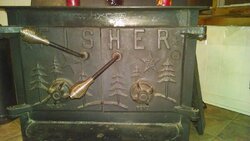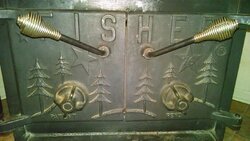Rare Grandpa Bear or not
- Thread starter Todd_C
- Start date
-
Active since 1995, Hearth.com is THE place on the internet for free information and advice about wood stoves, pellet stoves and other energy saving equipment.
We strive to provide opinions, articles, discussions and history related to Hearth Products and in a more general sense, energy issues.
We promote the EFFICIENT, RESPONSIBLE, CLEAN and SAFE use of all fuels, whether renewable or fossil.
You are using an out of date browser. It may not display this or other websites correctly.
You should upgrade or use an alternative browser.
You should upgrade or use an alternative browser.
- Status
- Not open for further replies.
Just noticed in the second pic there is a gap at the top between the doors . When I looked closer I noticed one at the top and one at the bottom. Are these normal? The doors open and close fine and line up straight.
If this is not normal. Does anyone have any suggestions for a quick repair. I plan on using it this winter and pulling it to restore it in the spring.
If this is not normal. Does anyone have any suggestions for a quick repair. I plan on using it this winter and pulling it to restore it in the spring.
Depends on one's definition of rare I guess. All '76 doors were from the first year the double door was produced. Some are older than others.
The first one built is only 1/4 mile down the road from the Fisher home. It is the one Bob was frustrated with making the two steel plate doors. Not sure if more like this exist.
The first ones had a 3 piece top. I'd consider them the rarest. Bending the tops from a single piece was already being done on the single door stoves in '76, so fabricators without a bending brake large enough to fit the wider top sheet had to go back to the old way before buying a new larger brake.
The first doors were not drilled completely through and did not use full rivets with heads. They all used round seal which is 1/2 steel rod welded to stove front. The inventor continued to use the round seal on his own stove line, the Frontier, and after fulfilling his stove quota with Bob, they agreed to terminate the contract.
The 4 fin caps that are his fathers invention, were the caps in use at the time. That doesn't mean fabricators across the country couldn't buy their own locally or make their own. Bob felt the cost of the original caps was high (He was against the price Baxter wanted and knew licensees would make their own) This was before there was standardization across the country among fabricators.
The tight wound stainless spring was also in use at the time by most, but some bought solid balls, and one even used a locally available round barrel shaped solid handle.
Yours is the most common '76. But still more rare than later years since there were not as many made the first year until production peaked.
Here is the door edge on my '76. This is one of the first with 3 piece top, and undrilled door hinge tabs. It seals well when closed. There is an overlap in the center of door that ends at the outer sealing edges where the round door seal notch is.
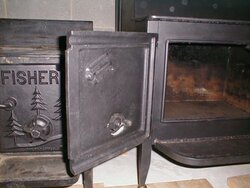
Here's the fit closed;
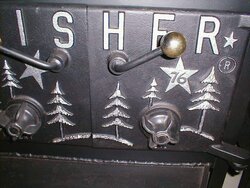
The first one built is only 1/4 mile down the road from the Fisher home. It is the one Bob was frustrated with making the two steel plate doors. Not sure if more like this exist.
The first ones had a 3 piece top. I'd consider them the rarest. Bending the tops from a single piece was already being done on the single door stoves in '76, so fabricators without a bending brake large enough to fit the wider top sheet had to go back to the old way before buying a new larger brake.
The first doors were not drilled completely through and did not use full rivets with heads. They all used round seal which is 1/2 steel rod welded to stove front. The inventor continued to use the round seal on his own stove line, the Frontier, and after fulfilling his stove quota with Bob, they agreed to terminate the contract.
The 4 fin caps that are his fathers invention, were the caps in use at the time. That doesn't mean fabricators across the country couldn't buy their own locally or make their own. Bob felt the cost of the original caps was high (He was against the price Baxter wanted and knew licensees would make their own) This was before there was standardization across the country among fabricators.
The tight wound stainless spring was also in use at the time by most, but some bought solid balls, and one even used a locally available round barrel shaped solid handle.
Yours is the most common '76. But still more rare than later years since there were not as many made the first year until production peaked.
Here is the door edge on my '76. This is one of the first with 3 piece top, and undrilled door hinge tabs. It seals well when closed. There is an overlap in the center of door that ends at the outer sealing edges where the round door seal notch is.

Here's the fit closed;

So if most of the bi centennial doors were on the grandma this would mean not a lot of grandpa's were made or sold that year? I see the curved notch on the top and bottom of your doors as well. Left door, center seam, has a curved notch on top and bottom. The doors on yours has a tighter fit in the center. I propped the handle up on the pic to show the 76 star. Were the handles supposed to be off kilter or level with each other? Also any way to tighten sloppy handles?
And did the original ones with plate doors have any markings that can be used to prove they were fishers? The reason being. I saw one the other day and the owner had a couple of old stoves in the back. One at first glance looked like a fisher baby bear. But had a steel door. So i chalked it up to a copy. I'm heading over there in a hour or two to take a closer look. Probably a goose chase. But one never knows. The Mama Bear has alot of pitting on the top. The guy left it out in the elements so it's pitted pretty badly.
Do you got a cure for this?
Your passion is steam engines? Mine is old bikes. Luckily my wife shares this with me. I'm currently working on a 1969 650 Triumph Bonneville. This bike has never seen the ground when it comes to the engine. No gouges scratches. Just really dirty. The bike was in a barn that had a fire on the other end. It was covered with a shag carpet. The carpet melted all over the bike. Mostly tank and controls took a beating. The guy raked the stearing yoke and did a nasty job of welding it. So I need to repair the frame. It sat from the late 70's till I got it. When my son and I drained the oil I told him the oil was older than he was. The wife and I had all four models of the honda 750 Super sport
Honda CB750F Super Sport Years produced: 1975-1978 Claimed power: 58hp @ 8,000rpm Top speed: 114mph Engine type: 736cc air-cooled SOHC inline four. But a friend schmoozed me out of the 78 I had. So now im either gonna have to search out a new one or not have all of them. Not having all of them is unacceptable to my wife. Pretty cool that she is into it as much as me. She has a FXRS as her normal bike. FXRS was the first totally redesigned frame Harley made after they baught HD back from AMF. It was designed around comfort and strength. Sported Triple rubber mounting of engine. ( Newer dyna and other HD's use double mount.) Her bike is totally custom ground on up. And is smokin fast. But it has one major problem. The thing is PINK frame and tins. They call them the Angel bike. Because alot of club members Hells Angels, Outlaws, Banditos, etc rode them. Coast to coast to coast. They dont fatigue ya on super long runs. Smooth with very little vibration. My favorites that I ride mostly are 95 Road king and 95 Dyna Lowrider. I tend to drive real fast so I mostly use the Dyan Glide. My AVATAR. Then there's the Royal Enfield the wife made me drive 500 plus miles one way to heckle over and bring home. Their history is amazing. I guess ya could say we collect bikes. The Enfield is a one lunger 500 cc and will break yer leg when ya kick it over if yer not carefull. My 49 Pan Head did a number on my knee in 79 and to this day I still feel it when i push it too hard. The darn thing tried to launch me over the bars. Now you guys got me addicted to Fisher Stoves. Hopefully the wife will get on board. Fingers crossed.
BTW I really appreciate the info you provide. I know how it is when I'm on a fact finding mission regarding bikes. One thing leads to another and the picture is never quite complete.
And did the original ones with plate doors have any markings that can be used to prove they were fishers? The reason being. I saw one the other day and the owner had a couple of old stoves in the back. One at first glance looked like a fisher baby bear. But had a steel door. So i chalked it up to a copy. I'm heading over there in a hour or two to take a closer look. Probably a goose chase. But one never knows. The Mama Bear has alot of pitting on the top. The guy left it out in the elements so it's pitted pretty badly.
Do you got a cure for this?
Your passion is steam engines? Mine is old bikes. Luckily my wife shares this with me. I'm currently working on a 1969 650 Triumph Bonneville. This bike has never seen the ground when it comes to the engine. No gouges scratches. Just really dirty. The bike was in a barn that had a fire on the other end. It was covered with a shag carpet. The carpet melted all over the bike. Mostly tank and controls took a beating. The guy raked the stearing yoke and did a nasty job of welding it. So I need to repair the frame. It sat from the late 70's till I got it. When my son and I drained the oil I told him the oil was older than he was. The wife and I had all four models of the honda 750 Super sport
Honda CB750F Super Sport Years produced: 1975-1978 Claimed power: 58hp @ 8,000rpm Top speed: 114mph Engine type: 736cc air-cooled SOHC inline four. But a friend schmoozed me out of the 78 I had. So now im either gonna have to search out a new one or not have all of them. Not having all of them is unacceptable to my wife. Pretty cool that she is into it as much as me. She has a FXRS as her normal bike. FXRS was the first totally redesigned frame Harley made after they baught HD back from AMF. It was designed around comfort and strength. Sported Triple rubber mounting of engine. ( Newer dyna and other HD's use double mount.) Her bike is totally custom ground on up. And is smokin fast. But it has one major problem. The thing is PINK frame and tins. They call them the Angel bike. Because alot of club members Hells Angels, Outlaws, Banditos, etc rode them. Coast to coast to coast. They dont fatigue ya on super long runs. Smooth with very little vibration. My favorites that I ride mostly are 95 Road king and 95 Dyna Lowrider. I tend to drive real fast so I mostly use the Dyan Glide. My AVATAR. Then there's the Royal Enfield the wife made me drive 500 plus miles one way to heckle over and bring home. Their history is amazing. I guess ya could say we collect bikes. The Enfield is a one lunger 500 cc and will break yer leg when ya kick it over if yer not carefull. My 49 Pan Head did a number on my knee in 79 and to this day I still feel it when i push it too hard. The darn thing tried to launch me over the bars. Now you guys got me addicted to Fisher Stoves. Hopefully the wife will get on board. Fingers crossed.
BTW I really appreciate the info you provide. I know how it is when I'm on a fact finding mission regarding bikes. One thing leads to another and the picture is never quite complete.
No total of Grandma and Grandpa are known. The '76 doors were only sold in 1976 and the early '77 still had the stars, but missing the 76 in the large star on right door.
Seems the Grandpa doors had the old style large trees and the Grandma had the shorter trees. I've never seen a different 76 Grandma door pattern as shown below;
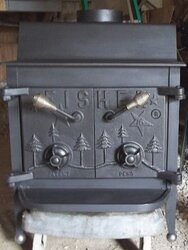
When the trees were added to the doors, the tall type were on the single door stoves and later Grandpa. It's like these short trees were the new style to come. BUT, here's an early Grandma with 3 piece top and the first doors without drilling hinge pins through. Even this early Grandma had the newer style trees. They didn't match Grandpa ! Can't answer it.
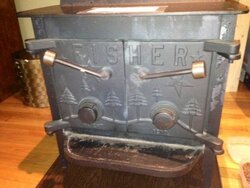 Notice fabricator supplied handles and caps. These handles were common from this fabricator for a time.
Notice fabricator supplied handles and caps. These handles were common from this fabricator for a time.
Another view showing 3 piece top;
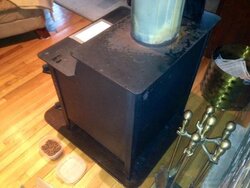 (no, the stove board pad isn't large enough)
(no, the stove board pad isn't large enough)
Perhaps Grandma came out later in the year than Grandpa using a foundry pattern made with the new style trees and they didn't make new patterns for Grandpa to match. Bob may have been so fed up at this point with doors, he didn't care as long as they worked!
It's difficult putting together changes as the stoves evolve differently made by fabricators that made the boxes to specs, ordered doors only, and had their own ways of finishing the product. (when the puzzle is put together, I use these differences to determine where the stove came from) It's not like a product that comes from a single factory or another division of that manufacturer making the same product. In '79 there were 42 makers across the US and Canada. When they started out, they couldn't make stoves fast enough. First came the stoves, which caused the need for safe installation procedures. Then insurance regulations, laws were drawn up for testing (which weren't standard across the US using 4 different testing labs since the state laws didn't recognize testing from other labs) and then smoke regulations became necessary with so many in operation. As Fisher International was formed, things became standardized so it becomes easier after 1978 when the testing standards used and all fabricators were under the same direction. It's more like putting the history behind each fabricators business together and finding where the different ideas came from that was behind the changes company wide. Combine all the changes being made by different fabricators making 15,000 to 25,000 stoves across the country a MONTH, businesses changing hands, some cutting corners to improve their bottom line, reverting back to the original owner in many cases............. You can only generalize when changes took place since they happened at different times across the country. Then add the fact that anyone with a garage and welder could make a stove and sell locally under the radar when the price of oil was going crazy and even being rationed. Some licensed builders would make their own version of plate stove and when Fisher came down on them, revoked their license, they would sell their doors to the competition or people building their own stoves.
I can speculate on a lot of origins of their products and ideas, but try to only answer with documented proof. Then something surfaces to contradict a document or proof.
I think I have more questions than everyone has asked combined !
Steel plate doors would only be from Oregon, possibly marked FSSO in weld on the bottom.
Yes, my steam hobby turned into a job on an excursion RR which included rebuilding and maintaining steam locomotives and equipment. After retirement from my own business, I rebuilt a few stationary engines. (they are more common and cheaper than traction engines, rollers and rolling equipment) Never got into miniature or model steam, only full size. The price has gone as crazy as Fisher Stoves in the last 10 years. A friend of mine that recently died had a "skimmer" that is a forerunner of a modern day backhoe. More like a cross between steam shovel and excavator. That's the kind of "stuff" I make parts for and work on. The green outrigger (foot) in the front is 6 inch pipe casing. It's BIG.
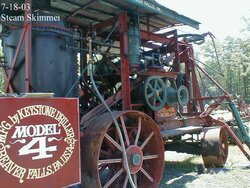
Seems the Grandpa doors had the old style large trees and the Grandma had the shorter trees. I've never seen a different 76 Grandma door pattern as shown below;

When the trees were added to the doors, the tall type were on the single door stoves and later Grandpa. It's like these short trees were the new style to come. BUT, here's an early Grandma with 3 piece top and the first doors without drilling hinge pins through. Even this early Grandma had the newer style trees. They didn't match Grandpa ! Can't answer it.
 Notice fabricator supplied handles and caps. These handles were common from this fabricator for a time.
Notice fabricator supplied handles and caps. These handles were common from this fabricator for a time.Another view showing 3 piece top;
 (no, the stove board pad isn't large enough)
(no, the stove board pad isn't large enough)Perhaps Grandma came out later in the year than Grandpa using a foundry pattern made with the new style trees and they didn't make new patterns for Grandpa to match. Bob may have been so fed up at this point with doors, he didn't care as long as they worked!
It's difficult putting together changes as the stoves evolve differently made by fabricators that made the boxes to specs, ordered doors only, and had their own ways of finishing the product. (when the puzzle is put together, I use these differences to determine where the stove came from) It's not like a product that comes from a single factory or another division of that manufacturer making the same product. In '79 there were 42 makers across the US and Canada. When they started out, they couldn't make stoves fast enough. First came the stoves, which caused the need for safe installation procedures. Then insurance regulations, laws were drawn up for testing (which weren't standard across the US using 4 different testing labs since the state laws didn't recognize testing from other labs) and then smoke regulations became necessary with so many in operation. As Fisher International was formed, things became standardized so it becomes easier after 1978 when the testing standards used and all fabricators were under the same direction. It's more like putting the history behind each fabricators business together and finding where the different ideas came from that was behind the changes company wide. Combine all the changes being made by different fabricators making 15,000 to 25,000 stoves across the country a MONTH, businesses changing hands, some cutting corners to improve their bottom line, reverting back to the original owner in many cases............. You can only generalize when changes took place since they happened at different times across the country. Then add the fact that anyone with a garage and welder could make a stove and sell locally under the radar when the price of oil was going crazy and even being rationed. Some licensed builders would make their own version of plate stove and when Fisher came down on them, revoked their license, they would sell their doors to the competition or people building their own stoves.
I can speculate on a lot of origins of their products and ideas, but try to only answer with documented proof. Then something surfaces to contradict a document or proof.
I think I have more questions than everyone has asked combined !
Steel plate doors would only be from Oregon, possibly marked FSSO in weld on the bottom.
Yes, my steam hobby turned into a job on an excursion RR which included rebuilding and maintaining steam locomotives and equipment. After retirement from my own business, I rebuilt a few stationary engines. (they are more common and cheaper than traction engines, rollers and rolling equipment) Never got into miniature or model steam, only full size. The price has gone as crazy as Fisher Stoves in the last 10 years. A friend of mine that recently died had a "skimmer" that is a forerunner of a modern day backhoe. More like a cross between steam shovel and excavator. That's the kind of "stuff" I make parts for and work on. The green outrigger (foot) in the front is 6 inch pipe casing. It's BIG.

I'm a city boy gone country. It's a whole new and fun world. I have a neighbor in his 70's that kinda adopted us and is helping us figure things out. He collects old tractors cockshutt are his favorites. he has old threshers that take belts to run. The belts take up most of a garage. they're really cool machines. Every year the drag em out and put on a show for the public. It takes days to set em up tear em down and do maintenance. The mechanics are incredible. They always say them dont make em like they used to for good reason. The fact that the ones that were taken care of are still around and working is a testament to just how well built they were. In this day things have built in obsolescence so they have to be replaced. It's all about the green backs. My neighboy still cuts cord wood everyday. Splits it by hand and refuses to use a log splitter. He says they're too slow. Very old school and very informative.
I refused to use a log splitter for 30 years too. Tell him he can only keep up with a Huskee 22 Ton for the first 15 minutes. Larger pieces and white oak you can't keep up with at all. At 1/2 hour you're behind. After an hour, you're done. The splitter's just getting warmed up.
I wouldn't think of splitting these by hand anymore.
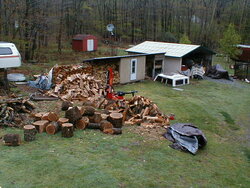 What these splitters won't split, they will cut right through. Over 22 Ton they do move slower, but I've never needed more power than that. They are 2 stage so they move faster until more power is needed when they go into low range and creep through. Vertical mode, you don't have to lift. Just roll into place and in half they go. The handle stays in return mode with wedge moving back while you position the next piece with two hands. The rounds on the ground would be done in the next hour, right AFTER splitting the pile already there. By hand huh?
What these splitters won't split, they will cut right through. Over 22 Ton they do move slower, but I've never needed more power than that. They are 2 stage so they move faster until more power is needed when they go into low range and creep through. Vertical mode, you don't have to lift. Just roll into place and in half they go. The handle stays in return mode with wedge moving back while you position the next piece with two hands. The rounds on the ground would be done in the next hour, right AFTER splitting the pile already there. By hand huh?
I wouldn't think of splitting these by hand anymore.
 What these splitters won't split, they will cut right through. Over 22 Ton they do move slower, but I've never needed more power than that. They are 2 stage so they move faster until more power is needed when they go into low range and creep through. Vertical mode, you don't have to lift. Just roll into place and in half they go. The handle stays in return mode with wedge moving back while you position the next piece with two hands. The rounds on the ground would be done in the next hour, right AFTER splitting the pile already there. By hand huh?
What these splitters won't split, they will cut right through. Over 22 Ton they do move slower, but I've never needed more power than that. They are 2 stage so they move faster until more power is needed when they go into low range and creep through. Vertical mode, you don't have to lift. Just roll into place and in half they go. The handle stays in return mode with wedge moving back while you position the next piece with two hands. The rounds on the ground would be done in the next hour, right AFTER splitting the pile already there. By hand huh?CamFan
Feeling the Heat
So if most of the bi centennial doors were on the grandma this would mean not a lot of grandpa's were made or sold that year? I see the curved notch on the top and bottom of your doors as well. Left door, center seam, has a curved notch on top and bottom. The doors on yours has a tighter fit in the center. I propped the handle up on the pic to show the 76 star. Were the handles supposed to be off kilter or level with each other? They were supposed to be off kilter as you say and show in the picture. Also any way to tighten sloppy handles? What do you mean sloppy handles?
And did the original ones with plate doors have any markings that can be used to prove they were fishers? The reason being. I saw one the other day and the owner had a couple of old stoves in the back. One at first glance looked like a fisher baby bear. But had a steel door. So i chalked it up to a copy. I'm heading over there in a hour or two to take a closer look. Probably a goose chase. But one never knows. The Mama Bear has alot of pitting on the top. The guy left it out in the elements so it's pitted pretty badly.
Do you got a cure for this? Yes sand blast. If you take stove bright paint and let it gel you can put it on with a putty knife let it dry and sand smooth then paint the whole stove
Your passion is steam engines? Mine is old bikes. Luckily my wife shares this with me. I'm currently working on a 1969 650 Triumph Bonneville. This bike has never seen the ground when it comes to the engine. No gouges scratches. Just really dirty. The bike was in a barn that had a fire on the other end. It was covered with a shag carpet. The carpet melted all over the bike. Mostly tank and controls took a beating. The guy raked the stearing yoke and did a nasty job of welding it. So I need to repair the frame. It sat from the late 70's till I got it. When my son and I drained the oil I told him the oil was older than he was. The wife and I had all four models of the honda 750 Super sport
Honda CB750F Super Sport Years produced: 1975-1978 Claimed power: 58hp @ 8,000rpm Top speed: 114mph Engine type: 736cc air-cooled SOHC inline four. But a friend schmoozed me out of the 78 I had. So now im either gonna have to search out a new one or not have all of them. Not having all of them is unacceptable to my wife. Pretty cool that she is into it as much as me. She has a FXRS as her normal bike. FXRS was the first totally redesigned frame Harley made after they baught HD back from AMF. It was designed around comfort and strength. Sported Triple rubber mounting of engine. ( Newer dyna and other HD's use double mount.) Her bike is totally custom ground on up. And is smokin fast. But it has one major problem. The thing is PINK frame and tins. They call them the Angel bike. Because alot of club members Hells Angels, Outlaws, Banditos, etc rode them. Coast to coast to coast. They dont fatigue ya on super long runs. Smooth with very little vibration. My favorites that I ride mostly are 95 Road king and 95 Dyna Lowrider. I tend to drive real fast so I mostly use the Dyan Glide. My AVATAR. Then there's the Royal Enfield the wife made me drive 500 plus miles one way to heckle over and bring home. Their history is amazing. I guess ya could say we collect bikes. The Enfield is a one lunger 500 cc and will break yer leg when ya kick it over if yer not carefull. My 49 Pan Head did a number on my knee in 79 and to this day I still feel it when i push it too hard. The darn thing tried to launch me over the bars. Now you guys got me addicted to Fisher Stoves. Hopefully the wife will get on board. Fingers crossed.
BTW I really appreciate the info you provide. I know how it is when I'm on a fact finding mission regarding bikes. One thing leads to another and the picture is never quite complete.
The doors on yours has a tighter fit in the center. I propped the handle up on the pic to show the 76 star. Were the handles supposed to be off kilter or level with each other?
They were supposed to be off kilter as you say and show in the picture. Also any way to tighten sloppy handles?
What do you mean sloppy handles?
The Mama Bear has alot of pitting on the top. The guy left it out in the elements so it's pitted pretty badly.
Do you got a cure for this?
Yes sand blast. If you take stove bright paint and let it gel you can put it on with a putty knife let it dry and sand smooth then paint the whole stove it will be a lot better.
The handle has a washer inside that is welded and it seems like the gap is too big so it is all woggedy. For lack of a better term. I realize it is supposed to be loose fitting enough to work smoothly. But this one wiggles alot.
Not a huge issue. But wondering if there's a quick fix. The mama bear has a real handle issue. When I close it I can continue the handle past that point and open it. It doesn't stop and stay in the closed position if you continue with the handle. It works for now but I'll have to fabricate another internal latch or try to repair the one in it. The Mama was very neglected. Rear broken leg with a angle iron welded in its place. I have the cast leg to repair it. But the lug is kaput.
Not a huge issue. But wondering if there's a quick fix. The mama bear has a real handle issue. When I close it I can continue the handle past that point and open it. It doesn't stop and stay in the closed position if you continue with the handle. It works for now but I'll have to fabricate another internal latch or try to repair the one in it. The Mama was very neglected. Rear broken leg with a angle iron welded in its place. I have the cast leg to repair it. But the lug is kaput.
CamFan
Feeling the Heat
Do you weld? If so I have the handles you have on the stove. What needs to be done is one of 3 things.
1. Remove the washer, you will need to either grind off the tacks to get the washer off. Get a 1/2 ID washer. They are available. Put the handle snug to the door. Put the new washer on and tack so it is snug. This will eliminate the Wobble.
2. Cut the handle off and replace handle and washer in the same method. You will have to bend the handle which is another process I can talk you through. I have bent hundreds of these. There is a knack.
There is a knack.
3. heat the existing washer and bend the edges toward the door to allow the edges of the washer to snug the handle up. this is a temp fix.
The wobble tho aggravating will not hurt if the handle locks.
The Mama issue is easy. Take a torch and heat the existing bend in the handle inside the stove. Take a pipe and slide over the end of the handle inside the stove and bend it a 1/4" or so then try to lock it in place. If you can still turn it past vend it in more. this is also how you would adjust the handles so they are both angled the same when the doors are closed. When the stoves are hot and someone really bears down to close it tight it can cause it to spread where it will not lock at all. but it is a good bargaining point to get a cheaper stove. Send a picture of the lug you are talking about. It should be a 1/2" thick piece of flat bar with a 45 degree cut on both ends welded in place and the bolt goes through this.
Send a picture of the lug you are talking about. It should be a 1/2" thick piece of flat bar with a 45 degree cut on both ends welded in place and the bolt goes through this.
1. Remove the washer, you will need to either grind off the tacks to get the washer off. Get a 1/2 ID washer. They are available. Put the handle snug to the door. Put the new washer on and tack so it is snug. This will eliminate the Wobble.
2. Cut the handle off and replace handle and washer in the same method. You will have to bend the handle which is another process I can talk you through. I have bent hundreds of these.
 There is a knack.
There is a knack. 3. heat the existing washer and bend the edges toward the door to allow the edges of the washer to snug the handle up. this is a temp fix.
The wobble tho aggravating will not hurt if the handle locks.
The Mama issue is easy. Take a torch and heat the existing bend in the handle inside the stove. Take a pipe and slide over the end of the handle inside the stove and bend it a 1/4" or so then try to lock it in place. If you can still turn it past vend it in more. this is also how you would adjust the handles so they are both angled the same when the doors are closed. When the stoves are hot and someone really bears down to close it tight it can cause it to spread where it will not lock at all. but it is a good bargaining point to get a cheaper stove.
 Send a picture of the lug you are talking about. It should be a 1/2" thick piece of flat bar with a 45 degree cut on both ends welded in place and the bolt goes through this.
Send a picture of the lug you are talking about. It should be a 1/2" thick piece of flat bar with a 45 degree cut on both ends welded in place and the bolt goes through this.If you don't have a welder, you can make or buy a collar with set screw to replace the inside washer with. Grind off washer, drill out a 1/2" nut so it fits down the bent shaft. Drill a hole in the side of the nut and thread it for a set screw. Push it tight against door and tighten screw.
CamFan
Feeling the Heat
If you don't have a welder, you can make or buy a collar with set screw to replace the inside washer with. Grind off washer, drill out a 1/2" nut so it fits down the bent shaft. Drill a hole in the side of the nut and thread it for a set screw. Push it tight against door and tighten screw.
I guess there are 4 options . But make sure the nut will clear the channel on the front of the stove or it will not allow the door to shut. I think out side of the box but I did not think of the set screw method.
- Status
- Not open for further replies.
Similar threads
- Replies
- 11
- Views
- 975
- Replies
- 8
- Views
- 2K
- Replies
- 1
- Views
- 853
- Replies
- 2
- Views
- 1K


